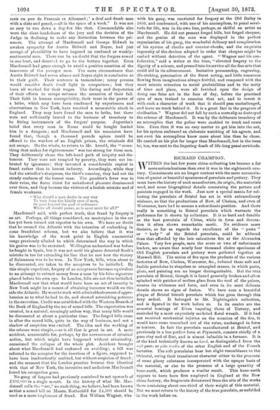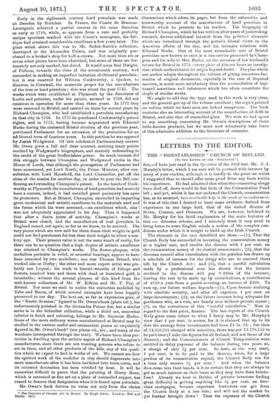RICHARD CHAMPION.
AATITHIN the last few years china-collecting has become a far V more serious business than ever it was in the eighteenth cen- tury. Connoisseurs are no longer content with the mere accumula- tion of quaint or beautiful specimens of porcelain and pottery. They must have the history of each manufacture, its origin, the materials used, and some biographical details concerning the potters and painters engaged in the work. Just now a special mania for col- lecting the porcelain of Bristol has set in with extraordinary violence, so that the productions of Bow, of Chelsea, and even of Worcester, have had to assume a subordinate position. And there really is something in Bristol porcelain which warrants the preference for it shown by collectors. It is as hard and durable as the best porcelain of China, while in form and decora- tion it often shows remarkable merit. No evidence more decisive, so far as regards the excellence of the " paste " or " body" of the Bristol porcelain, could be adduced than that afforded by the late calamitous fire at the Alexandra Palace. Very few people, save the score or two of unfortunate lenders, are aware that nearly four thousand choice specimens of Old English porcelain and pottery were gathered together at Muswell Hill. The action of fire upon the products of the various factories of Bow, Chelsea, Worcester, &c., reduced these soft and fusible porcelains to shapeless or crumpled masses, in which paste, glaze, and painting are no longer distinguishable. But the true porcelain of Bristol, though it is found generally broken and often splashed with patches of molten glass from the roof of the palace, retains its whiteness and form, and even in its most delicate details shows no signs of fusion. We have seen a beautiful plaque of Bristol biscuit porcelain which has gone through this fiery ordeal. It belonged to Mr. Nightingale's collection, and is figured in the work before us. In its centre are the armorial bearings of Elton impaling those of Tierney, and encircled by a most exquisitely modelled floral wreath. If it had not received mechanical injuries on the occasion of the fire, it would have come unscathed out of the ruins, unchanged in form or texture. In fact the porcelain manufactured at Bristol, and previously in a leas perfect form at Plymouth, consists chiefly of a pure clay and of flint, and is almost infusible in a furnace. It is of the kind technically known as hard, as distinguished from the soft paste or piiie tendre of the other English and of the French factories. The soft porcelains bear but slight resemblance to the Oriental, owing their translucent character either to the presence of some glassy substance incorporated with the opaque basis of the material, or else to the presence of a large quantity of bone-earth, which produces a similar result. This bone-earth appears to have been first employed in England at the Bow china factory, the fragments disinterred from the site of the works there containing about one-third of their weight of this material. But we must return to the history of the true porcelain, as unfolded in the work before us. Early in the eighteenth century hard porcelain was made at Dresden by Biittcher. In France, the Comte de Brancas- Lauraguais achieved a partial success in the same direction as early as 1748, while, as appears from a rare and probably unique specimen marked with the Count's monogram, his fab- rique had attained considerable excellence a few years later. The piece which shows this was in Mr. Soden-Smith's collection, destroyed at the Alexandra Palace, and was originally pur- chased in a broker's shop for half-a-crown. Not more than six or seven other pieces have been identified, but some of these are for- tunately not only marked, but dated. It would seem that Dwight, .of Fulham, towards the close of the seventeenth century, had 'succeeded in making an imperfect imitation of Oriental porcelain ; but it was reserved for William Cookworthy, a Quaker, to discover, in Cornwall, the materials proper for the manufacture -of the true or hard porcelain ; this was about the year 1745. The works which were established at Plymouth by the discoverer of 'kaolin and petuntse, under his patent, secured in 1768, did not .continue in operation for more than three years. In 1771 they were removed to Bristol, and carried on there for several years by Richard Champion, who had established a porcelain manufactory in that city in 1768. In 1773 he purchased Cookworthy's patent Tights, and in 1775, having become acquainted with Edmund Burke during the contested Bristol election of the previous year, petitioned Parliament for an extension of the protection for an additional term of fourteen years. In this petition he was opposed =by Josiah Wedgwood. Of this celebrated Parliamentary contest Mr. Owen gives a full and clear account, noticing many points omitted by Wedgwood's biographers, and scarcely redounding to the credit of the great Staffordshire potter. So much interest did this struggle between Champion and Wedgwood excite in the House of Lords, that although the prorogation of Parliament had been announced, yet Lord North, the Prime Minister, after con- Imitation with Lord Mansfield, the Lord Chancellor, put off the -close of the session for another day, in order to pass the Bill con- firming and extending Champion's patent. In the hands of Cook- -worthy at Plymouth the manufacture of bard porcelain had scarcely been a success, indeed, it had entailed great pecuniary loss upon its promoters. But at Bristol, Champion succeeded in imparting _great mechanical and artistic excellence to the materials used and the forms which his ware assumed,—an excellence which, alas!. was not adequately appreciated in his day. Thus it happened that after a dozen years of activity, Champion's works at ,Bristol were closed, and the manufacture of real porcelain in England ceased, not again, so far as we know, to be revived. The 'very pieces which are now sold for three times their weight in gold could not find purchasers for less than their weight in silver a can- ary ago. Their present value is not the mere result of rarity, for there can be no question that a high degree of artistic excellence was attained in Champion's works. The flower-plaques, with medallion portraits in relief, or armorial bearings, appear to have been executed by two modellers ; one was Thomas Briand, who 'worked also at Derby ; the other and more expert artist was pro- bably one Lequoi ; his work in biscuit-wreaths of foliage and dowers, touched here and there with dead or burnished gold, is 'inimitable; witness the several plaques of this kind from the well-known collections of Mr. W. Edkins and Mr. F. Fry, of Bristol. Nor must we omit to notice the statuettes modelled by Tebo and Bacon, of which several examples have been happily preserved to our day. The best set, so far as expression goes, of the "Rustic Seasons;" figured in Mr. Owen's book (plate xxi.), has unfortunately perished in the Alexandra Palace fire, but a similar series is in the Schreiber collection, while a third set, somewhat inferior in finish and colouring, belongs to Mr. Seymour Haden. Some of the more ordinary wares manufactured at Bristol may be -studied in the various useful and ornamental pieces so exquisitely figured in Mr. Owen's book* (see plates vii., xiv., and many of the woodcuts interspersed through the text). We have been thus par- ticular in dwelling upon the artistic aspect of Richard Champion's manufactures, since there are not wanting persons who refuse to 'see in these, and all other products of the kiln, any of the quali- ties which we expect to find in works of art. We cannot see how the spirited work of the modeller in clay should degenerate into mere manufacture after it has been hardened into terra-cotta, and its coloured decoration has been vitrified by heat. It will be somewhat difficult to prove that the painting of Henry Bone, which is esteemed as fine art on a plate of enamelled copper, has 'ceased to deserve that designation when it is found upon porcelain.
Mr. Owen's book derives its value not only from the choice
Two Centuries of Ceramic Art in Bristol. By Hugh Owen. London: Bell and Daldy. 187d.
illustrations which adorn its pages, but from the exhaustive and trustworthy account of the manufacture of hard porcelain in Bristol which he presents to his readers. The biography of Richard Champion, which he has written after years of painstaking research, derives additional interest from the political elements which are introduced through the potter's liberal views on the American affairs of the day, and his intimate relations with Edmund Burke. One of the most remarkable sets of Bristol porcelain now known to exist is a tea-service presented by Cham- pion and his wife to Mrs. Burke, on the occasion of her husband's return for Bristol in 1774 ; every piece of this set bears an inscrip- tion which authenticates its origin beyond doubt. The plan which our author adopts throughout the volume of giving numerous fac- similes of original documents, especially in the case of disputed matters, is much more satisfactory than the accumulation of hap- hazard assertions and inferences which too often constitute the staple of similar works.
We ought to add that the type used in this work is very clear, and the general get-up of the volume excellent ; the copies printed on vellum which we have seen are indeed sumptuous. The book contains also an interesting account of the manufacture of delft in Bristol, and also that of enamelled glass. We wish we had space to say something concerning Mr. Owen's descriptions of these little-known products, but we must now reluctantly take leave of this admirable addition to the literature of ceramics.































 Previous page
Previous page